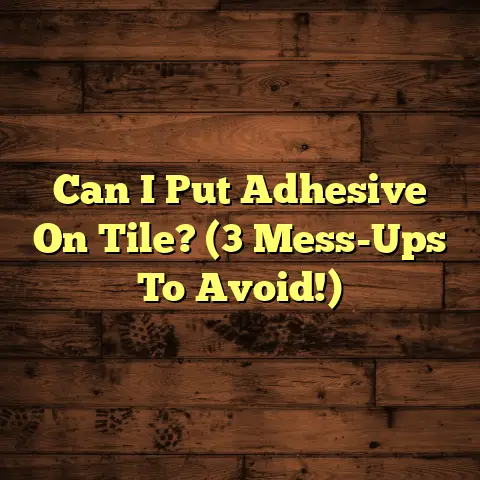Sandpaper Grit for Hardwood (DIY Mistake?)
I get it.
The allure of saving money and getting that perfect custom look is strong.
But let me tell you, as a flooring contractor with years under my belt, that hardwood refinishing can be a real beast if you don’t know what you’re doing.
And one of the biggest pitfalls?
Sandpaper grit.
Choosing the wrong grit can turn your dream floors into a scratched-up nightmare faster than you can say “polyurethane.”
So, let’s dive deep into the world of sandpaper and hardwood, and I’ll share some insider secrets to help you avoid those common (and costly) DIY mistakes.
1. Understanding Sandpaper Grit: The Basics
Okay, let’s start with the fundamentals.
What exactly is sandpaper grit?
Simply put, it’s a measure of the abrasive particles on the sandpaper.
Think of it like this: imagine tiny little rocks glued to a piece of paper.
The “grit” number tells you how big those rocks are.
The lower the number, the bigger the rocks (coarser grit).
The higher the number, the smaller the rocks (finer grit).
- Coarse grits (24-40): These are your heavy hitters, designed for removing old finishes, leveling uneven surfaces, or tackling serious imperfections.
- Medium grits (50-80): These are your workhorses, smoothing out the scratches left by the coarse grits and preparing the surface for finer sanding.
- Fine grits (100-150): These are your finesse artists, creating a smooth, even surface ready for staining or finishing.
- Very fine grits (180-220+): These are used for between coats of finish to smooth out any imperfections in the finish and prep for the next coat.
The Grit Scale Explained
Pro Tip: Always remember that each grit builds upon the last.
You’re not just removing material; you’re refining the surface.
2. Choosing the Right Grit for Your Hardwood Flooring Project
Now, let’s get down to brass tacks.
How do you pick the right grit for your specific project?
Well, it depends.
Types of Hardwood Floors
- Unfinished Hardwood: This is a blank slate!
You’ll need to sand it completely, starting with a coarser grit to level the floor and remove any imperfections, then working your way up to finer grits for a smooth finish. - Pre-finished Hardwood: These floors already have a factory finish.
If you’re just refreshing them, you might only need a light sanding with a fine grit to scuff the surface and prepare it for a new coat of finish.
However, if you want to change the color or remove heavy wear, you’ll need to sand more aggressively. - Engineered Hardwood: This type has a thin veneer of real wood over a plywood core.
Be very careful!
You don’t want to sand through the veneer.
Light sanding with fine grits is usually best.
The Recommended Grit Sequence
This is a general guideline, but it’s a good starting point:
- Initial Sanding (if needed): 36-40 grit (for removing old finishes or leveling)
- Medium Sanding: 60-80 grit (to smooth out scratches)
- Fine Sanding: 100-120 grit (to prepare for finish)
- Between Coats (optional): 180-220 grit (to smooth finish)
Factors Influencing Grit Selection
- Wood Type: Softer woods like pine require a lighter touch than harder woods like oak or maple.
You might need to adjust your grit sequence accordingly. - Condition of the Floor: If your floors are heavily damaged or have a thick, stubborn finish, you’ll need to start with a coarser grit.
If they’re in relatively good shape, you can start with a medium grit. - Desired Finish: A high-gloss finish requires a smoother surface than a matte finish.
You might need to go up to a higher grit for that extra level of smoothness.
Personal Story: I once worked on a project where the homeowner insisted on starting with 80 grit on a floor that had layers of old varnish.
It took forever to get through the finish, and we ended up wasting a ton of sandpaper.
Starting with a coarser grit would have saved us a lot of time and effort.
3. Common DIY Mistakes with Sandpaper Grit
Alright, let’s talk about the mistakes I see homeowners make all the time.
- Skipping Grits: This is a big one!
Don’t jump from 40 grit to 120 grit.
You’ll end up with deep scratches that are difficult to remove. - Using Too Coarse a Grit: This can gouge the wood and leave permanent marks.
Remember, you can always remove more material, but you can’t put it back. - Using Too Fine a Grit: This can clog the sandpaper and make it ineffective.
It can also burnish the wood, preventing the stain or finish from adhering properly. - Not Changing Sandpaper Often Enough: Dull sandpaper is your enemy!
It won’t cut effectively and can actually damage the wood.
Change it frequently, especially when using coarse grits. - Ignoring the Edges: The edges of the room are just as important as the center.
Use an edger with the same grit sequence as your drum sander to ensure a consistent finish.
Consequences of Using the Wrong Grit
- Unsightly Scratches: These will be visible through the finish and can ruin the look of your floors.
- Uneven Finish: The stain or finish may not absorb evenly if the surface isn’t properly prepared.
- Finish Failure: The finish may peel or flake if it doesn’t adhere properly to the wood.
- Wasted Time and Money: You’ll have to re-sand the floors, which means more time, more sandpaper, and more frustration.
Anecdote: I had a client who tried to refinish their floors themselves and ended up with swirl marks everywhere because they used too coarse a grit and didn’t overlap their passes properly.
They had to hire me to fix it, which cost them even more money in the long run.
4. The Sanding Process: Step-by-Step Guide
Okay, let’s walk through the sanding process, step by step.
Preparation
- Clear the Room: Remove all furniture, rugs, and other items from the room.
- Clean the Floor: Sweep or vacuum the floor thoroughly to remove any dirt, dust, or debris.
- Inspect the Floor: Look for any nails, staples, or other protrusions that could damage the sander.
Remove or countersink them. - Protect Yourself: Wear a dust mask, safety glasses, and ear protection.
Execution
- Start with the Coarsest Grit: Load your drum sander with the appropriate grit (usually 36-40 grit for removing old finishes).
- Sand with the Grain: Always sand in the direction of the wood grain.
- Overlap Your Passes: Overlap each pass by about 50% to ensure even sanding.
- Keep the Sander Moving: Don’t stop the sander while it’s on the floor, or you’ll create a divot.
- Edge the Room: Use an edger with the same grit as your drum sander to sand the edges of the room.
- Repeat with Medium and Fine Grits: Repeat the sanding process with progressively finer grits (60-80 grit, then 100-120 grit).
- Vacuum Thoroughly: Vacuum the floor thoroughly after each sanding pass to remove all dust and debris.
Recommended Grit Progression (Example)
Testing Sandpaper Effectiveness
Before you commit to sanding the entire floor, test the sandpaper on a small, inconspicuous area.
This will help you determine if the grit is appropriate and if your technique is correct.
5. Techniques and Tools for Effective Sanding
Let’s talk about the tools you’ll need and some techniques to help you get a professional-looking finish.
Tools
- Drum Sander: This is the primary tool for sanding large areas.
- Edger: This is used to sand the edges of the room, where the drum sander can’t reach.
- Hand Scraper: This is useful for removing finish from corners and tight spots.
- Vacuum: A good vacuum with a HEPA filter is essential for dust control.
- Sandpaper: Of course!
Make sure you have plenty of sandpaper in the grits you need.
Techniques
- Overlapping Passes: As mentioned before, overlapping your passes is crucial for even sanding.
- Maintaining a Consistent Speed: Don’t go too fast or too slow.
A consistent speed will help you avoid swirl marks. - Lifting the Sander at the End of Each Pass: This will prevent the sander from digging into the floor.
- Using Proper Posture: Keep your back straight and your knees bent to avoid fatigue.
Dust Control
Dust control is essential for a clean, safe, and professional-looking job.
- Seal Off the Room: Cover doorways and vents with plastic sheeting to prevent dust from spreading.
- Use a Vacuum with a HEPA Filter: This will capture the fine dust particles that can be harmful to your health.
- Empty the Vacuum Bag Frequently: A full vacuum bag will reduce its effectiveness.
- Wear a Dust Mask: Protect your lungs from dust inhalation.
6. Finishing Touches: After Sanding
You’ve sanded your floors, now what?
Staining
If you’re planning to stain your floors, now’s the time.
- Choose a Stain Color: Consider the style of your home and the color of your furniture.
- Apply the Stain Evenly: Use a brush, roller, or rag to apply the stain in thin, even coats.
- Wipe Off Excess Stain: After a few minutes, wipe off any excess stain with a clean rag.
- Let the Stain Dry Completely: Follow the manufacturer’s instructions for drying time.
Sealing
Sealing your floors will protect them from moisture and wear.
- Choose a Sealer: There are many different types of sealers available, including polyurethane, varnish, and lacquer.
- Apply the Sealer Evenly: Use a brush, roller, or applicator pad to apply the sealer in thin, even coats.
- Let the Sealer Dry Completely: Follow the manufacturer’s instructions for drying time.
Finishing
Finishing your floors will give them a beautiful, durable surface.
- Choose a Finish: There are many different types of finishes available, including polyurethane, varnish, and lacquer.
- Apply the Finish Evenly: Use a brush, roller, or applicator pad to apply the finish in thin, even coats.
- Let the Finish Dry Completely: Follow the manufacturer’s instructions for drying time.
- Sand Between Coats (Optional): Sand lightly between coats of finish with 220 grit sandpaper to remove any imperfections.
How Sandpaper Grit Affects Stain Absorption
The grit you use during sanding can affect how well your floors absorb stain.
If you sand too finely, the wood pores may be closed, preventing the stain from penetrating properly.
If you sand too coarsely, the stain may absorb unevenly, resulting in a blotchy appearance.
Maintaining Your Hardwood Floors
- Sweep or Vacuum Regularly: This will remove dirt and debris that can scratch the finish.
- Use a Damp Mop: Use a damp mop with a mild cleaner to clean your floors.
- Avoid Harsh Chemicals: Harsh chemicals can damage the finish.
- Use Rugs in High-Traffic Areas: Rugs will protect the finish from wear and tear.
7. Conclusion: Reflecting on the DIY Experience
Refinishing hardwood floors is a challenging but rewarding DIY project.
By understanding the importance of sandpaper grit and following the steps outlined in this article, you can achieve professional-looking results.
Remember, preparation is key.
Take the time to research your project, gather the right tools and materials, and practice your techniques.
And don’t be afraid to ask for help if you need it.
With a little knowledge, patience, and elbow grease, you can transform your old, worn-out floors into a beautiful and durable surface that you’ll be proud of for years to come.
And who knows, you might even discover a new passion for DIY home improvement!
So, go out there and give it a try.
I believe in you!
And if you ever get stuck, you know where to find me.
Happy sanding!




